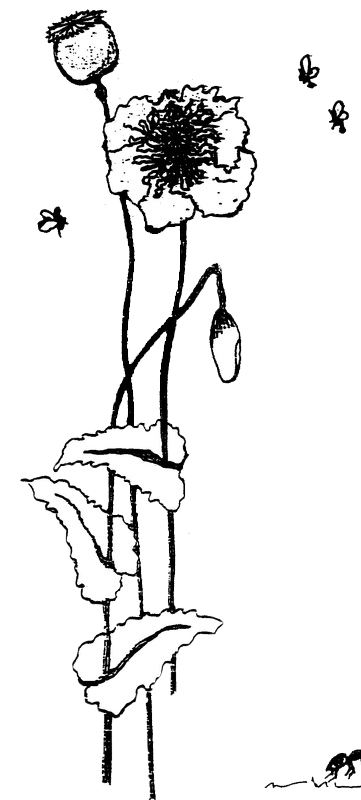
Cottage
Garden Design
‘promoting cottage gardening
in southeast Queensland’
What is a cottage garden?
A cottage garden includes a mix of herbs, flowers and vegetables. Cottage gardens often surrounded workers’ cottages in the nineteenth century and provided a practical collection of food, herbals and ornamentals. Today this traditional gardening style, having undergone many changes over the years, remains popular and has been adapted to suit the different climatic zones in Australia. There is something intimate, comforting and homely about a cottage garden; the memories of grandparents’ gardens, soft colours and scents, a garden to be shared with friends and the wonderful bond formed between garden lovers and through the sharing of plants.
Herbs are an integral part of the cottage garden. Most literature written on herb and perennial growing is written for temperate areas. When it is suggested that these plants be grown in full sun, it is usually best to give them some protection from the hot afternoon sun of summer in the subtropics. Plant on the eastern side of the house or under trees where they will have filtered sunlight on summer afternoons. Raising beds, to create a well-drained site, is very important when growing herbs and temperate climate perennials as many of them originate from the drier Mediterranean areas. The use of mulch is imperative as this keeps the soil surface cooler during summer. Many herbs prefer an alkaline soil so the addition of dolomite or lime to the soil is beneficial. Culinary sage, lavender and rosemary definitely benefit from a dusting of dolomite on their leaves throughout the humid months.
Plants for a subtropical cottage garden
Salvias: Salvia elegans, S. iodantha, S. madrensis, S. wagneriana, S. ‘Waverly’, S. gesneriiflora, S. ‘Costa Rica Blue’, S. involucrata ‘Bethellii’, S. involucrata x karwinskii, S. ‘Indigo Spires’, S. ‘Marine Blue’, S. mexicana ‘Lime Calyx’, S. leucantha ‘Midnight’, S. chiapensis, S. ‘Purple Majesty’, S. ‘Phyllis Fancy’, S. ‘Anthony Parker’ S. ‘Amistad’, ‘S. Rosh Eden’, S. ‘Wendy’s Wish’, S. ‘Love & Wishes’, S. ‘Embers Wish’, Heatwave range, So Cool range and many varieties of microphylla.
(refer to the book ‘Salvias in southeast Queensland’ available through the group)
Old-fashioned roses including Teas, Chinas, Noisettes and Polyanthas: Rosa ‘Crepuscule’ (noisette): ‘Mme Antoine Mari’, ‘Dr Grill’ (tea), ‘Marie van Houtte’ (tea), ‘Cecile Brunner’, ‘Monseir Tillier’ (tea), ‘Lorraine Lee’ (tea), ‘Duchesse de Brabant’ (tea), ‘Bloomfield Abundance’, ‘Spring Song’ (Reithmuller 1954), ‘Rosette Delizy’, ‘Mutabilis’, ‘Perle d’Or’, ‘The Fairy’, ‘Hazel Anne’, ‘Green Ice’.
Perennials: Tagetes lemonii, Tagetes lucida (winter tarragon), gaillardia, perennial statice, coreopsis, angelonia (Granny’s bonnet), pink erigeron daisy, dianthus, pentas, verbena, shasta daisy, yarrow, chrysanthemum, rudbeckia, echinacea, lemon verbena, heliotrope, feverfew, penstemon, nepeta (catmint), marjoram, rosemary, Lavandula dentata, Lavandula stoechas, gaura, scutellaria, Otacanthus caeruleus ‘Little Boy Blue’, barleria, bidens, asystasia, Artemisia ‘Valerie Finnis’, Artemisia ‘Powis Castle’, Artemisia ‘Lambrook Silver’, southernwood, wormwood, thyme varieties, Michaelmas daisies (asters).
Annuals: cosmos, Queen Anne’s lace, love-in-the-mist, alyssum, cynoglossum (Chinese forget-me-not), torenia, poppy, calendula, nasturtium, heartsease, cleomes, Malva sylvestris, Geranium robertum (herb Robert) and zinnias.
Culinary herbs and subtropical leafy greens: Chinese purple mustard, Basella alba (Ceylon spinach), mustard lettuce, varieties of basil, an assortment of chillies and peppers and perennial rocket, Eryngium foetidum (false coriander), turmeric, ginger, Murraya koenigii (curry tree), Kaffir lime, Alternanthera sissoo, (Brazilian spinach), Gynura crepioides (Okinawa spinach) and Talinum triangulare (Surinam spinach).
Fragrant species: datura, stephanotis, jasmine, Osmanthus fragrans, gardenia, Ipomoea alba (moonflower), frangipani, michelia, Osmanthus fragrans.
Bulbs, corms and tubers: Zephyranthes (storm crocus), (ifafa lilies), babiana, freesia, Lilium longiflorum, Leucojum (snowflake), hippeastrum, haemanthus, gladiolus, crinum, crocosmia, alstroemeria, (calla lily) watsonia, Tulbaghia violacea, Tulbaghia fragrans, oxalis, tuberose (Polianthes tuberosa), kniphofia, daylilies, clivea, cannas and agapanthus.
Scented pelargoniums: Robers lemon rose, coconut, apple, candy dancer, concolour, peppermint, apple, candy dancer.
Rainforest plants: Backhousia citriodora (lemon scented myrtle), Backhousia anisata, Backhousia myrtifolia, Randia fitzalanii (native gardenia, now known Atractocarpus fitzalanii), Cananga odorata (Ylang ylang), Hymenosporum flavum (native frangipani) and Phalaria clerodendron.
Native shrubs: Graphtophyllum exculsum (native fuchsia) Leptospermum petersonii.
Trees and shrubs: Lagerstroemia indica (crepe myrtle), rondeletia, Viburnum odoratissimum, Spiraea cantoniensis (May bush), Clerodendrum ugandense (butterfly bush), tibouchina, Grewia occidentalis ‘Lavender star’, brunfelsia, Tetradenia riparia (nutmeg bush), gordonia, Euphorbia leucocephala (snowflake bush), Michelia ‘Mixed up Miss’, Michelia ‘Coco’, Dombeya, Magnolia ‘Little Gem’.
Burgundy foliage: Euphorbia cotinifolia, Breynia cernua ‘Ironstone Range’ and Loropetalum chinense ‘China Pink’.
Autumn colour: Betula nigra (tropical birch), Sapien sebiferum (Chinese tallow tree)) swamp cypress and liquidambar, crepe myrtle. Nyssa sylvatica, Pyrus calleryana (Bradford pear).
Hedging: dwarf murraya, austromyrtus, syzygium species, phylanthus multiflorus.
Climbers: Quisqualis ‘Jessie Star’, Antignon leptopus, Ipomoea horsfalliae, Petrea volubilis, Thunbergia mysorensis, jasmin, Vigna caracalla (snail creeper), Beaumontia grandiflora, Solanum wendlandii, allamanda, bougainvillea.
Fruit trees. Citrus, jaboticaba, acerola cherry, wax jambu, wampi, dwarf mulberry and carambola.
Read More
Salvias: Salvia elegans, S. iodantha, S.madrensis, S. wagneriana, S. ‘Waverly’, S. gesneriiflora, S. ‘Costa Rica Blue’, S. involucrata ‘Bethellii’, S. involucrata x karwinskii, S. ‘Indigo Spires’, S. ‘Marine Blue’, S. mexicana ‘Lime Calyx’, S. leucantha ‘Midnight’, S. chiapensis, S. ‘Purple Majesty’, S. ‘Phyllis Fancy’, S. ‘Anthony Parker’ S. ‘Amistad’, ‘S. Rosh Eden’, S. ‘Wendy’s Wish’, S. ‘Love & Wishes’, S. ‘Embers Wish’, Heatwave range, So Cool range and many varieties of microphylla.
(refer to the book ‘Salvias in southeast Queensland’ available through the group)
Old-fashioned roses including Teas, Chinas, Noisettes and Polyanthas: Rosa ‘Crepuscule’ (noisette): ‘Mme Antoine Mari’, ‘Dr Grill’ (tea), ‘Marie van Houtte’ (tea), ‘Cecile Brunner’, ‘Monseir Tillier’ (tea), ‘Lorraine Lee’ (tea), ‘Duchesse de Brabant’ (tea), ‘Bloomfield Abundance’, ‘Spring Song’ (Reithmuller 1954), ‘Rosette Delizy’, ‘Mutabilis’, ‘Perle d’Or’, ‘The Fairy’, ‘Hazel Anne’, ‘Green Ice’.
Perennials: Tagetes lemonii, Tagetes lucida (winter tarragon), gaillardia, perennial statice, coreopsis, angelonia (Granny’s bonnet), pink erigeron daisy, dianthus, pentas, verbena, shasta daisy, yarrow, chrysanthemum, rudbeckia, echinacea, lemon verbena, heliotrope, feverfew, penstemon, nepeta (catmint), marjoram, rosemary, Lavandula dentata, Lavandula stoechas, gaura, scutellaria, Otacanthus caeruleus ‘Little Boy Blue’, barleria, bidens, asystasia, Artemisia ‘Valerie Finnis’, Artemisia ‘Powis Castle’, Artemisia ‘Lambrook Silver’, southernwood, wormwood, thyme varieties, Michaelmas daisies (asters).
Annuals: cosmos, Queen Anne’s lace, love-in-the-mist, alyssum, cynoglossum (Chinese forget-me-not), torenia, poppy, calendula, nasturtium, heartsease, cleomes, Malva sylvestris, Geranium robertum (herb Robert) and zinnias.
Culinary herbs and subtropical leafy greens: Chinese purple mustard, Basella alba (Ceylon spinach), mustard lettuce, varieties of basil, an assortment of chillies and peppers and perennial rocket, Eryngium foetidum (false coriander), turmeric, ginger, Murraya koenigii (curry tree), Kaffir lime, Alternanthera sissoo, (Brazilian spinach), Gynura crepioides (Okinawa spinach) and Talinum triangulare (Surinam spinach).
Fragrant species: datura, stephanotis, jasmine, Osmanthus fragrans, gardenia, Ipomoea alba (moonflower), frangipani, michelia, Osmanthus fragrans.
Bulbs, corms and tubers: Zephyranthes (storm crocus), (ifafa lilies), babiana, freesia, Lilium longiflorum, Leucojum (snowflake), hippeastrum, haemanthus, gladiolus, crinum, crocosmia, alstroemeria, (calla lily) watsonia, Tulbaghia violacea, Tulbaghia fragrans, oxalis, tuberose (Polianthes tuberosa), kniphofia, daylilies, clivea, cannas and agapanthus.
Scented pelargoniums: Robers lemon rose, coconut, apple, candy dancer, concolour, peppermint, apple, candy dancer.
Rainforest plants: Backhousia citriodora (lemon scented myrtle), Backhousia anisata, Backhousia myrtifolia, Randia fitzalanii (native gardenia, now known Atractocarpus fitzalanii), Cananga odorata (Ylang ylang), Hymenosporum flavum (native frangipani) and Phalaria clerodendron.
Native shrubs: Graphtophyllum exculsum (native fuchsia) Leptospermum petersonii.
Trees and shrubs: Lagerstroemia indica (crepe myrtle), rondeletia, Viburnum odoratissimum, Spiraea cantoniensis (May bush), Clerodendrum ugandense (butterfly bush), tibouchina, Grewia occidentalis ‘Lavender star’, brunfelsia, Tetradenia riparia (nutmeg bush), gordonia, Euphorbia leucocephala (snowflake bush), Michelia ‘Mixed up Miss’, Michelia ‘Coco’, Dombeya, Magnolia ‘Little Gem’.
Burgundy foliage: Euphorbia cotinifolia, Breynia cernua ‘Ironstone Range’ and Loropetalum chinense ‘China Pink’.
Autumn colour: Betula nigra (tropical birch), Sapien sebiferum (Chinese tallow tree)) swamp cypress and liquidambar, crepe myrtle. Nyssa sylvatica, Pyrus calleryana (Bradford pear).
Hedging: dwarf murraya, austromyrtus, syzygium species, phylanthus multiflorus.
Climbers: Quisqualis ‘Jessie Star’, Antignon leptopus, Ipomoea horsfalliae, Petrea volubilis, Thunbergia mysorensis, jasmin, Vigna caracalla (snail creeper), Beaumontia grandiflora, Solanum wendlandii, allamanda, bougainvillea.
Fruit trees. Citrus, jaboticaba, acerola cherry, wax jambu, wampi, dwarf mulberry and carambola.
Excerpt from ‘Much more in a Brisbane cottage garden’
by Denise Horchner
In a subtropical cottage garden adaptations have to be made, and many exotics are usually mixed in with the more traditional plants, resulting in a charming profusion of colour, fragrance and texture, with a very relaxed feel to it all. This type of garden doesn’t reveal its beauty all at once; year round you will find something interesting in flower or about to bloom. You will enjoy the company of butterflies, birds, and bees, and because of the wide diversity of plants, will have very little trouble with insects. Grasshoppers will be one of the main pests. These can be kept under control, at least the enormous ones, by catching them with long-handled tongs when they are very sleepy early in the morning. Please don’t tell me what you do with them, after that.
A cottage garden can be just as you like it, there are no rules but generally speaking a lot of use is made of perennials and herbs, bulbs and unusual annuals, and of course the many wonderful climbers that are available to us, plants that add another interesting dimension. Flowers on tall spikes rising above the other plants give the charming, much desired English cottage garden look. Some of these include hollyhocks (the biggest spike of all), foxgloves, delphiniums, campanulas, clarkias, goldenrods, and so on. A cottage garden is about plants that have ‘more of charm than of fashion’, plants that are very evocative of memories, feelings and associations. Visitors to your garden will often share these with you, some happily, others sadly, but the latter will surely leave your garden comforted.
If your plants have come from southern states, it is wise to understand that the directions shown on the label are not always suited to our conditions. Often when the label says ‘full sun’ our fierce subtropical sun will be too much for them, so place them in a kinder position. Also, many of these plants will grow at least 50% taller and wider than the size shown, so remember this when you are siting them in your garden! I have to admit that this can be a bit like a game of musical chairs.
If you aren’t already a member, join a garden club. There is a band of hard working people who form the Queensland Council of Garden Clubs. The Queensland Council of Garden Clubs Inc. was established in April 1967 as an organisation to encourage friendship and co-operation between garden clubs. There are now more than 130 member garden clubs, plant societies and other special interest groups, from Cairns to Tweed Heads. https://www.qcgc.net/
The Garden Clubs of Australia Inc. is a non-profit organisation that provides a range of services to the members of their affiliated clubs around Australia. The organisation produces a quarterly magazine called Our gardens and the cost is $20 for a year for 4 issues posted to you. Download a personal subscription form at www.gardenclubs.org.au or send your name, postal and email addresses with a cheque or bank transfer details to Subscriptions Officer Rob Horton, 44 Mid Dural Road, Middle Dural 2158 or subscriptions@gardenclubs.org.au The magazines are full colour and feature many interesting articles. Further information is available at https://gardenclubs.org.au/
On numerous occasions, people have told me they wouldn’t be able to join a garden club because they knew so little about gardening! I ask them “But where else can you learn?” And I tell them that by becoming a member they will also make new like-minded friends. Read anything and everything you can that is written for gardening in Queensland.
If you have young children, or grandchildren, encourage them to follow in your green-fingered footsteps and take up this hobby. It will bring them much joy and satisfaction for the rest of their lives. Start them off with easy, fast growing, colourful plants. These suit children who like to see quick results. Let them press in a few runner bean or cucumber seeds among your flowers, or grow some of the wide variety of lettuce that now come in punnets. They will feel so proud a few weeks later when they are able to get something from the garden for you to use in a meal. Nasturtium flowers are always a favourite with little ones as well as giant sunflowers which are quick and easy from seed and make a huge impression!
Read More
In a subtropical cottage garden adaptations have to be made, and many exotics are usually mixed in with the more traditional plants, resulting in a charming profusion of colour, fragrance and texture, with a very relaxed feel to it all. This type of garden doesn’t reveal its beauty all at once; year round you will find something interesting in flower or about to bloom. You will enjoy the company of butterflies, birds, and bees, and because of the wide diversity of plants, will have very little trouble with insects. Grasshoppers will be one of the main pests. These can be kept under control, at least the enormous ones, by catching them with long-handled tongs when they are very sleepy early in the morning. Please don’t tell me what you do with them, after that.
A cottage garden can be just as you like it, there are no rules but generally speaking a lot of use is made of perennials and herbs, bulbs and unusual annuals, and of course the many wonderful climbers that are available to us, plants that add another interesting dimension. Flowers on tall spikes rising above the other plants give the charming, much desired English cottage garden look. Some of these include hollyhocks (the biggest spike of all), foxgloves, delphiniums, campanulas, clarkias, goldenrods, and so on. A cottage garden is about plants that have ‘more of charm than of fashion’, plants that are very evocative of memories, feelings and associations. Visitors to your garden will often share these with you, some happily, others sadly, but the latter will surely leave your garden comforted.
If your plants have come from southern states, it is wise to understand that the directions shown on the label are not always suited to our conditions. Often when the label says ‘full sun’ our fierce subtropical sun will be too much for them, so place them in a kinder position. Also, many of these plants will grow at least 50% taller and wider than the size shown, so remember this when you are siting them in your garden! I have to admit that this can be a bit like a game of musical chairs.
If you aren’t already a member, join a garden club. There is a band of hard working people who form the Queensland Council of Garden Clubs. The Queensland Council of Garden Clubs Inc. was established in April 1967 as an organisation to encourage friendship and co-operation between garden clubs. There are now more than 130 member garden clubs, plant societies and other special interest groups, from Cairns to Tweed Heads. https://www.qcgc.net/
The Garden Clubs of Australia Inc. is a non-profit organisation that provides a range of services to the members of their affiliated clubs around Australia. The organisation produces a quarterly magazine called Our gardens and the cost is $20 for a year for 4 issues posted to you. Download a personal subscription form at www.gardenclubs.org.au or send your name, postal and email addresses with a cheque or bank transfer details to Subscriptions Officer Rob Horton, 44 Mid Dural Road, Middle Dural 2158 or subscriptions@gardenclubs.org.au The magazines are full colour and feature many interesting articles. Further information is available at https://gardenclubs.org.au/
On numerous occasions, people have told me they wouldn’t be able to join a garden club because they knew so little about gardening! I ask them “But where else can you learn?” And I tell them that by becoming a member they will also make new like-minded friends. Read anything and everything you can that is written for gardening in Queensland.
If you have young children, or grandchildren, encourage them to follow in your green-fingered footsteps and take up this hobby. It will bring them much joy and satisfaction for the rest of their lives. Start them off with easy, fast growing, colourful plants. These suit children who like to see quick results. Let them press in a few runner bean or cucumber seeds among your flowers, or grow some of the wide variety of lettuce that now come in punnets. They will feel so proud a few weeks later when they are able to get something from the garden for you to use in a meal. Nasturtium flowers are always a favourite with little ones as well as giant sunflowers which are quick and easy from seed and make a huge impression!
Welcome butterflies into your garden
Welcome butterflies into your garden
Can there be anything more delightful than to watch butterflies flirting with the flowers in your garden? As with the little bees working the flowers, they bring such a feeling of peace and contentment and sense of continuity. A cottage garden with its wide diversity of flowering plants makes a happy place for these delightful, delicate creatures. The wonderful designs and brilliant colours provide nectar as a reward for them transferring pollen from one flower to another.
Some kinds of butterflies prefer certain colours and it is interesting to observe this habit in your garden when they flit from flower to flower. They are not able to extract nectar from flowers where it is difficult to get at (especially tubular flowers) so it is easy to understand that they prefer plants with large numbers of small, shallow flowers.
We have noticed in autumn there seem to be butterflies everywhere in our garden and this is because the year’s main crop of chrysalises have opened up and flown away. One can only marvel that the ‘Great Planner’ has organised it so that this is also the time of year when many butterfly-friendly plants are in flower.
Here are just a few of the many plants that you can grow to attract butterflies: Mexican sunflower (Tithonia rotundifola) (beloved of the wanderer butterfly), buddleia, nutmeg bush, pentas, coreopsis, zinnias, phlox, verbena, pansies and straw daisies. There are good books on butterflies; some are available from Brisbane City Council libraries.
“Just living is not enough,” said the butterfly
“One must have sunshine, freedom
And a little flower”
Hans Christian Andersen
Fragrant plants
Moonflower!
Glorious twining, winding thing
Do you know the joy you bring
With silky saucers, starry white
Wafting fragrance thru’ the night?
D. Horchner
Plants with fragrant flowers
Alyssum
Allamanda
Arabian jasmine (Jasminum sambac)
Buddleia
Cherry pie (Heliotropium aborescens)
Climbing oleander (Strophanthus gratus)
Crinum lily
Dwarf white cedar (Melia azedarach)
Eucharis lily
Freesia
Gardenia
Gordonia
Herald’s trumpet (Pyrostegia venusta)
Hoya
Jasminum ‘Grand Duke of Tuscany’
Jasminum ‘Grand Emperor’
Jasminum polyanthum
Jonquil ‘Erlicheer’
‘Lady of the night’ (Brunfelsia americana)
Magnolia ‘Little Gem’
Michelia ‘Coco’
Mock gardenia (Tabernaemontana divaricata)
Moonflower (Ipomoea alba)
Night scented tobacco (Nicotiana sylvestris)
November lily (Lilium longiflorum)
Nutmeg bush (Tetradenia riparia)
Osmanthus fragrans
Quisqualis
Rondoletia
Snail creeper (Vigna caracalla)
Star jasmine (Trachelospermum jasminoides)
Stephanotis
Stock
Viola dissecta
Violet
Virginian stock (Malcolmia maritima)
White ginger
Wintersweet (Acokanthera oblongifolia)
Yesterday, today and tomorrow (Brunfelsia australis)
Favourites: Osmanthus fragrans with its delicious, penetrating scent of ripe apricots coming from tiny white flowers; this shrub likes an acid soil.
Jasminum polyanthum, that twining, deliciously scented harbinger of spring. Sadly the flowers only last about three weeks, and then it is gone for another year. Watch the runners on this one, as they can spread out along the ground and dig themselves in, becoming quite invasive and difficult to dig out.
Night-scented tobacco, the species true to name whose snow-white flowers unfold as evening comes, pouring the most delightful, sweetest of fragrances into the cool night air. Absolutely heavenly. The climbing oleander is a bushy climbing plant with sweet smelling peachy-pink flowers that are like an enlarged version of the true oleander flowers.
Stephanotis is a surprisingly hardy climber, whose gorgeous white, waxy flowers are often used in bridal bouquets the world over. An old name for this plant is Hawaiian wedding flower. It is not hard to grow and can take quite a lot of sun.
Growing from seed
Growing from seed
‘Fluffy, frothy, feathery, furry, shiny, spotted, soft, or sticky, leathery, large, round, rough, hard, or hairy, pointed, prickly, fat, clingy, crinkly, and seeds with wings to take them over the hills and far away’
D. Horchner
Growing seeds in our climate is quite an easy thing to do as long as you adhere to a few simple rules. First, it is most important to fill your seed raising trays with a good seed raising mix, then use something like a thin bamboo stick to mark a line. Then thinly sow the seeds along the row, covering them lightly with a thin layer of the seed raising mixture. Large seeds are planted a little more deeply than tiny ones. Press the soil and seeds down with the flat of your hand and then water gently (I use a hand held spray that has had a good pinch of Epsom Salts® added to the water which I definitely think aids germination). Put the seed tray away in a shady place and keep moist but not too wet until the little seedlings start to appear when they should be brought out into a brighter light to harden off. Remember that some seed will take much longer to germinate than others so don’t be too impatient!
To me there is nothing more exciting than checking a seed box to find dozens of little tiny plants raising their heads. When they are about 4cm high (or look strong enough) gently lever them out of the soil and place in a little pot. Don’t put a tiny seedling in too large a pot as they do much better if ‘potted on’, increasing the pot size until they are big enough to go out into the garden. Shelter from heavy rain.
I always dunk each plant in a bucket of water containing Seasol® before transplanting them into the garden, then watering again with this solution when this has been done, to settle them in. This might take a little bit more time but it greatly helps with transplant shock and you will find your plants will never look back. It is wise not to plant out on a very hot or windy day and in summer, late afternoon is the best time to do this, in winter plant in the morning. Do not let a few failures disenchant you with seed growing, persist and you will be rewarded.
Check the seed catalogues in gardening magazines and send away for them. Your garden club also may hold a seed bank of unusual plants. I have always found Yates seeds to be very reliable, also New Gippsland Seeds and Diggers Club in Victoria. If you become a member of Diggers, they send out the most wonderful, comprehensive catalogue of seeds (including many heritage varieties of vegetables). Mail order is also available for perennials, roses, shrubs, etc.
Herbs
A collection of herbs
Beautiful, practical herbs are an integral part of a cottage garden and like many cottage plants, have been around since ancient times. I am only giving the briefest list of those that grow well in Brisbane as the subject is huge and there are many excellent books easily available that comprehensively cover this delightful subject.
Almost all herbs thrive in plenty of sunlight but in our climate, a position protected from the hot afternoon sun (in summer) for these plants is advisable. Growing them in pots makes it easy to do this. Plants should be regularly nipped back to give good air circulation around the plants during the wet season.
Here are just a few of the most popular herbs that do well for us in this climate:
Aloe vera – a very useful herb for your medicine chest.
Basil – there are a number of varieties both annual and perennial. The annual form is the most popular for cooking, while the perennial Greek basil, which is a nice looking plant, has a much stronger in flavour.
Dill, chives, fennel, five-in-one (Coleus amboinicus), garlic chives, lemon balm, lovage, marigold, marjoram and oregano.
A bay tree and clump of lemon grass are a must.
The mint family will do well, including applemint, pennyroyal, peppermint, spearmint.
Oregano, curly leaf and flat leaf parsley, pot marigold, rosemary, rosella, sage, salad burnet, salad rocket, summer savory, shallot, French tarragon, lemon and pizza thyme.
Insect repellent herbs such as wormwood and southernwood.
Coriander is one of the most popular culinary herbs and its dainty white flowers (like a miniature Queen Anne’s lace) mingle most attractively when mixed in with other plants. It rushes to seed and is best grown in the cooler months. The seeds and leaves of coriander have quite different flavours and are used for different purposes.
False coriander (Eryngium foetidum) is a good alternative and a most wonderful substitute. It is a perennial that flowers prolifically and is available all season.
Garlic is an amazing herb and one of the most powerful natural antibiotics known. It is a fact that during WWII there was a huge shortage of antibiotics, and the British Government bought up tons of garlic bulbs which were sent out to the Front. In the field hospitals the raw juice was expressed, diluted with water and applied to compressed pads of sphagnum moss which were then used to cover wounds to fight infection. This was credited with saving the lives of many soldiers.
Comfrey (knitbone) is a must for your herb garden and apart from its many other uses, some of its leaves thrown on your compost heap greatly assists in breaking everything down. Use as a compress for sprains or breaks.
Other interesting species include Chinese purple mustard, Ceylon spinach, (Basella alba) cardamom, chillies and peppers. Turmeric with its numerous medicinal uses and beautiful tropical flowers makes it a must for a cottage garden.
The curry tree (Murraya koenigii) makes a useful addition, but grow it in a pot as it is invasive. Many herbs make good pot plants, in particular members of the mint family which can become quite invasive.
A plant with perhaps the purest fragrance of all is lemon verbena (Aloysia triphylla) which I have seen described as having more lemon than a lemon tree or any of its parts, every leaf a distillation of lemon drops.
There is a very active herb society in Brisbane whose members regularly meet. They publish an excellent magazine called Sage. Once a year the society holds a Herb Awareness event. There is always an impressive array of herbs and other plants for sale at modest prices.
Rosemary for remembrance
‘As for Rosemary, I lette it runne all over my garden walls, not onlie because my bees love it, but because it is the herb sacred to remembrance.
Sir Thomas More
Rosemary, like lavender is one of the traditional herbs for a cottage garden and no garden should be without a bush or two. The name rosemary means ‘dew of the sea’ and in the year 1717 a famous diarist, John Evelyn, wrote that thirty leagues out to sea off the coast of southern France he could smell the fragrance from the thousands of rosemary plants that were growing on the cliffs at that time. I have found them to be very hardy growing in this climate, but although they often have flowers, they are not in the same amount as those plants grown in southern states. There are many species of rosemary and some do better than others in Brisbane.
Species I have found to do well include the large bush Rosmarinus officinalis and a superb variety named ‘Tuscan Blue’ which has upright growth like rods (I like this one very much). This variety is excellent for culinary use.
Another type, ‘Santa Barbara’ is a semi-prostrate variety that is used extensively in the landscaping of coastal gardens. It has glossy, deep green foliage with beautiful mid-blue flowers and is tough and reliable.
When growing lavender good drainage is a must, as over water it and you will pay the price. It is wise not to plant any of the grey-leaved plants where there are permanent sprinklers installed. This applies to other plants too, as not all plants appreciate the same amount of water.
Lavender, sweet lavender
‘And marjoram notts, sweet briar and ribbon grass
And lavender the choice of every lass
And sprigs of lad’s love, all familiar names
Which every garden thro’ the village claims.’
John Clare
Ah, sweet lavender! This ancient plant, beloved of cottage gardeners the world over. Lavender was found in Tutankhamen’s tomb. Doesn’t that give you goose bumps when you think about it?
Many gardeners seem to have trouble with this plant and to be honest it took me a long time to find out how to grow lavender well but once I did, no problem. Now, for a start, the French lavender (Lavendula dentata) and the Italian lavender (Lavendula stoechas) are the species I have found to be the very best for this part of the world. I have tried many other varieties which, although they were lovely, succeeded for a short time only. One particular plant of French lavender lasted eight years in my garden before it really declined, but often they get a bit tatty long before that. A little hint, never prune lavender back too hard, especially don’t cut back to the hard wood. A gentle snipping over now and again is all it needs.
If you strike little tip cuttings in sharp sand in spring and late summer/autumn you will always have a supply of fresh plants on hand. Take cuttings early in the day when the plants are full of moisture. French lavender is not used in any culinary way.
I have found that English lavender (Lavendula angustifolia) which is of Mediterranean origin despite its common name, does not do well for me, although I have tried many times. This is probably because this species grows wild in the mountains of Provence at an altitude of approximately 1000m. This is the type to use for cooking purposes. Have you ever tried lavender mustard? English lavender is the only species used in top perfumery.
Lavendula pinnata ‘Sidonie’ is an interesting Australian species, with very long thin purple flowers; it is very graceful and seems to be able to cope with higher humidity; but still it is not very long lived. In the hinterlands of the Gold and Sunshine Coast, other varieties no doubt do very well.
A golden rule for lavenders, indeed for many grey leaved plants, is full sun and good drainage. There must be good air circulation around the plants so don’t crowd them in with other things. If it should be very humid, throw a little lime over the leaves. The lime helps keep the foliage dry and will eventually wash down to the soil beneath and make a special treat for this most lovely of all cottage plants. Also, a mulch of silver sand throws heat upwards to keep the undersides of the leaves dry.
Hints
Hints
Dividing perennials: After a clump has been dug out, (late autumn is the best time of year to do this) many perennials can be pulled into separate rooted sections with your hands, but sometimes you may need to use a sharp, serrated knife. When replanting, remember that the outer plants taken from the clump are likely to grow the best because they are more vigorous than the central old sections.
A team of gardeners carried out a test of different hanging basket liners to see how they performed in comparison to each other. They used five proprietary liners: sphagnum moss, coco fibre, rigid papier-mache, carpet underlay, and an old woolly jumper. The moss and the coco fibre produced good results, but by far the best result came from the old woolly jumper!
To have a tree stump removed from your property can be a costly business. Why not leave it be and just plant it up with the fast growing, climbing pink foxglove (Asarina erubescens). If you have such a plant already in your garden, you will know that little baby plants come up everywhere so you can plant them all around. I have seen it done and the effect has been delightful. Sometimes chicken wire can assist the initial setting of the plants.
A deterrent for blackspot on roses: Make a foliar spray by dissolving 2 uncoated aspirin tablets (325mg) in 1 litre water, also good for frangipani rust.
Pelargoniums
Scented geraniums
Another of the joys of a cottage garden! The scented leaf geraniums are botanically known as the genus Pelargonium, but the name ‘geranium’ came about because of its nostalgic association with cottage gardens of long ago. They should not be confused with the true geraniums which are known as cranesbills from which the word geranium is derived. Geranos – a crane. They get this name from the shape of the seed.
The rose scented type seem to be the most loved and there are about 20 varieties, a number of them having traces of lemon or peppermint, even spice or camphor in their make-up. Scented geraniums mostly have quite insignificant flowers, it is the beautifully scented leaves that are so attractive.
P. graevolens is the one with the strongest rose scent, it makes a fairly large plant and has deeply lobed fragrant leaves and pink or mauve flowers. Other rose scented varieties include ‘Lady Plymouth’, with beautiful cream-edged leaves, ‘Snowflake’, whose name reflects the snow-spotted leaves and has a lovely rose fragrance, ‘Candy Dancer’, and hardy ‘Rober’s Lemon Rose’ whose fragrance apparently has a tendency to make one drowsy. ‘Attar of Roses’ has deep lobed angular leaves that are slightly hairy, with a strong rose scent.
The lemon scented varieties include the tiny leaved P. crispum ‘Prince Rupert’, a very attractive form with silver and cream edged leaves. P. crispum ‘Variegatum’ is a much smaller version of P. crispum, and another variety that has the fragrance of crushed lemon peel is P. crispum ‘Minor’. This delightful little plant, called the ‘finger bowl’ geranium has tiny ruffled leaves and lavender coloured flowers. As its name suggests the leaves can be used floated in finger bowls for special occasion meals or in summer drinks.
Then there is P. citriodorum ‘Mabel Grey’, which is considered to have the strongest fragrance of any plant in the scented section. Merely brushing past the plant brings forth a very strong lemon scent, (plant it by the side of a path), and dried leaves of this variety retain their lovely scent for a prolonged period of time.
Fruit scented geraniums are usually fairly true to name, such as the orange, P. nervosum, and lime P. triodorum, and apple P. odoratissimum. The apple scented form is a compact plant with scalloped fresh green leaves that smell typically of Granny Smith apples. It bears sprays of tiny white flowers.
P. nervosum, which smells of fresh limes has small green leaves with jagged edges and lavender flowers. P. grossularoides spreads widely and has small, rounded, dark green leaves and tiny cyclamen-coloured flowers that have a strong coconut scent.
Of all the mint scented geraniums a particular favourite which has been around for a long time is P. tomentosum. Its large downy, strongly peppermint scented leaves that are often used in cooking. This is a large spreading plant, which needs plenty of room and makes a good ground cover in a shady spot in the garden. Pelargonium ‘Joy Lucille’ is a cross between P. graveolens and P. tomentosum, with the same 3-lobed leaf shape. All lobes are scalloped and toothed and have some of the velvety softness of the former. Its scent is rose-peppermint and this very attractive plant bears rounded heads of rose-pink flowers.
Next come the spice-scented geraniums, the spiciest of which is the very popular nutmeg, P. fragrans. This is an attractive neatly growing plant with rounded crinkly grey-green leaves. There is an even more attractive variegated form, P. fragrans ‘Snowy Nutmeg’ but this variety can be a bit difficult to obtain.
Pungent geraniums often have leaves that have an oily scent and a sticky feel. A particularly aromatic geranium is the ‘oak leaf geranium’, P. quercifolium which has maroon markings up the veins of leaves that are shaped like those of the oak tree. It has been known for over 200 years and has been a parent plant to many hybrids. It is a pelargonium that tolerates shade fairly well. P. denticulatum has finely dissected ferny leaves while P. ficifolium has almost skeletal type foliage.
I used to believe that all geraniums had to have full sun, but once again that is mainly for gardens in the cooler parts of this country. I grow most of my geraniums in pots (a good potting mix works well) in a bright light in semi-shade in summer and then move them to full sun during the winter months. Fast draining soil of course, is important. Organic fertilisers are good to use but sometimes I use one of the granular types. Late summer and autumn months are a good time to strike cuttings of all geraniums including the scented leaf types and the following is a good mix to use for this purpose:
6 parts river sand (or propagating mix from nursery)
one handful of peat moss (or coir) plus 5 grams dolomite
Select nice firm cuttings and remove all but the top three or four leaves. You can let these cuttings dry out for a few hours, and then dip them in a dry striking compound before using a pencil to make a suitable hole in the mix to place them in. Only water sparingly, geraniums do not like to be too wet. Alternatively, as many people do, just cut off a nice sized piece from a plant and stick it in the ground. It’s pretty rough doing it like this but many cuttings will root this way without any trouble.
Plants for various areas
Some shrubs that bloom for a long period
Allamanda
Brazilian red cloak (Megaskepasma erythroclamys)
Cestrum
Chinese hat plant (Holmskioldia sanguinea)
Chinese lantern (Abutilon hybridum)
Darwin bells (Strobilanthes ‘Darwin Bells’)
Golden candles (Pachystachys lutea)
Hydrangea
Ixora
Lavender star (Grewia occidentalis)
Mussaenda
Pink monkey tails (Stachytarpheta mutabilis)
Plumbago
Wintersweet (Acokanthera oblongifolia)
Wrightia
Favourites: Brazilian red cloak is a wonderful, very long blooming, large shrub for background planting with huge candles of rosy-red flowers. Nothing eats it and it’s always fresh and green. Golden candles is another marvel, always showing dozens of golden candle flowers. Tough and decorative.
Wintersweet (a fire retardant large shrub) has very poisonous sap and seeds, but easily forgiven as it fills the garden with delicious fragrance all through winter from thick sprays of white flowers. It is very tough, but still very decorative.
Pink monkey tails is unusual, quaint, and lovely. Cestrum, a tall, very tough shrub that always seem to be in bloom is very good to use as a backdrop for other plants.
Dainty creeping plants
Aluminium plant (Pilea cadierei)
Baby’s tears (Soleirolia soleirolii)
Creeping Charlie (Pilea nummulariifolia)
Iresine herbstii ‘Purple Lady’
Mazus pumilio
Native violet
Parma violet
Pratia pedunculata
Seaside daisy (Erigeron karvinskianus)
Toadflax (Linaria genistifolia)
Variegated plectranthus
Favourites: Baby’s tears makes a good plant to fill an old bird bath, or to creep around in the shade. Variegated plectranthus is such a good plant as it lights up a shady corner. Iresine, has a beautiful low growing form. All the creeping plants make good hanging basket subjects.
Plants for damp shady places
Agapanthus
Aluminium plant (Pilea cadierei)
Arum lily
Baby’s tears (Soleirolia soleirolii)
Blue bugle flower (Ajuga reptans)
Blue ginger (Dichorisandra thrysiflora)
Clivia
Evergreen hydrangea (Dichroa versicolor)
Hydrangea
Iresine herbstii ‘Purple Lady’
Justicia
Leopard plant (Farfugium japonicum ‘Aureomaculata’)
Liriope
Maidenhair fern
Mazus pumilio
Mint
Mondo grass
Native violet
Plectranthus coleoides
Pratia
Variegated alstroemeria
Favourites: Blue ginger, a very good, tall plant with spires of waxy flowers of the richest royal blue. Hardy. The evergreen hydrangea is a wonderful hydrangea-like plant with interesting flowers of the strangest, brightest blue, and as its name implies is evergreen. I love the ‘happy wanderer’, the sweet little native violet. The leopard plant with its custard spotted leaves is most attractive, but any plain green leaves that may come now and again, should be cut off.
A few plants for hard dry shade
Butcher’s broom (Ruscus aculeatus)
Clivia
Cuphea
Shady lady (Plectranthus argentatus)
Snowflake bush (Euphorbia leucocephala)
St. John’s wort (Hypericum calysinum)
Variegated alstroemeria
Favourites: A favourite shrub for these conditions is the ‘snowflake bush’ which is amazingly hardy. It grows practically on top of the roots of a large palm in our garden. Don’t plant this one near a street light as its flowering pattern behaves oddly if you do.
St John’s wort is indeed a tough plant, growing and flowering beautifully in our garden in extremely difficult conditions. This hardy little bushy plant only grows to about 1m and when it blooms, the showy yellow flowers with their long ‘spangly’ stamens are very pleasing to the eye. My plant flowers very well in shade, in conditions opposite to those recommended in gardening books.
Ground cover plants
Aluminium plant (Pilea cadierei)
Arctotis daisy
Baby sunrose (Aptenia cordifolia)
Blue bugle flower (Ajuga repens)
Convolvulus
Creeping Charlie (Pilea nummulariifolia)
Evening primrose (Oenothera speciosa)
Evolvulus pilosus
Fairy fan flower (Scaevola aemula)
Geranium incanum
Golden chamomile (Anthemis tinctoria)
Iresine herbstii ‘Purple Lady’
Nasturtium
Native violet
Plectranthus coleoides
Seaside daisy (Erigeron karvinskianus)
Star jasmine (Trachelospermum jasminoides)
‘Stripe Me Pink’ (Rhoeo spathacea)
Toadflax (Linaria genistifolia subsp. dalmatica)
Variegated alstroemeria
Zinnia haageana
Favourites: The seaside daisy with its pretty tiny pink and white daisy flowers is an extremely hardy ground cover and when it is fresh and new it is quite delightful. It was one of Edna Walling’s favourite plants. However, it can become a bit of a nuisance so it is better to cut it right back now and again. There is a new cultivar ‘Spindrift’ that does not spread so much. ‘LA Pink’ is also a more recent cultivar and not so vigorous.
Evening primrose, but remember that is can also be rampant but I still find it one of the prettiest plants in my cottage garden and will stick up for it to the end of my days! (Good for letterbox planting).
The perennial Zinnia haageana in full bloom always attracts a lot of attention. It bears many little orange flowers with a dark centre and is extremely hardy.
‘Oh what a tangled web we weave, when into a heap
the hose we heave!’
Plants for a shady position
Aluminium plant (Pilea cadierei)
Arabian jasmine (Jasminum sambac)
Arum lily
Blue bugle flower (Ajuga repens)
Blue ginger (Dichorisandra thrysiflora)
Brazil torch (Megaskepasma erythroclamys)
Campanula
Carex
Chandelier plant (Clerodendrum wallichii)
Coleus
Chinese lantern (Abutilon hybridum)
Clivia
Crinum lily
Curcuma lily (Curcuma australasica)
Eucharis lily
Evergreen hydrangea (Dichroa versicolor)
Foxglove
Golden candles (Pachystachys lutea)
Golden slipper vine (Thunbergia mysorensis)
Gordonia
Hydrangea
Ifafa lily
Iresine
Japanese windflower (Anemone hupenhensis var. japonica)
Justicia
Leopard plant (Farfugium japonicum ‘Aureomaculata’)
Liriope
Little boy blue (Otancanthus caeruleus)
Maidenhair fern
Mazus pumilio
Medinilla
Mock Erica (Physostegia virginiana)
Native violet
Parma violet
Peace lily
Persian shield (Strobilanthes dyerianus)
Pratia
Primula
Rondoletia
Ruellia macrantha
Shady lady (Plectranthus argentatus)
‘Stripe Me Pink’ (Rhoeo spathacea)
Thryptomene
Vallota lily (Cyrtanthus elatus)
Variegated alstroemeria
Favourites: Gordonia, a beautiful shrub with large glossy white blooms with a boss of gold stamens that nearly always fall ‘sunny-side-up’ on to the ground. Persian shield has vividly purple foliage that looks lovely growing next to something gold.
Plants that form large clumps
Agapanthus
Angelonia
Artemisia
Catmint (Nepeta cataria)
Centrantherum
Cherry pie (Heliotropium aborescens)
Clivea
Coral plant (Russellia equisetiformis)
Cuphea
Curry plant (Helichrysum angustifolium)
Day lily
Dianella
Evolvulus
Goldenrod dwarf (solidago)
Lavender
Leopard plant (Farfugium japonicum ‘Aureomaculata’)
Liriope
Marguerite daisy
Marjoram
Oregano
Ostespermum
Perennial statice
Rudbeckia
Ruellia brittoniana
Santolina
Shasta daisy
‘Stripe Me Pink’ (Rhoeo spathacea)
Turnera elegans ‘Early bird’
Variegated astroemeria
White butterfly bush (Gaura lindheimeri)
Small clumping plants
Achillea
Alternanthera dentata ‘Little Ruby’
Bidens ‘Goldmound’
Cherry pie (Heliotropium aborescens)
Double feverfew (Tanacetum parthenium)
Dwarf gaillardia
Fairy fan flower (Scaevola aemula)
Goldenrod dwarf (Solidago)
Lobelia
Nasturtium
Penstemon
Rain lily (Habranthus sp.)
Santolina
Seaside daisy (Erigeron karvinskianus)
Santolina
Toadflax (Linaria genistifolia subsp. dalmatica)
Torenia
Verbena
Violet
Zephyranthes
Zinnia linearis
Sweet Violets
Sweet violets
Do you know that the more you smell violets, the less you can smell them?
This is because violets have a substance called ionine in them that actually sedate the nerves in your nose so that after the first one or two sniffs, you are puzzled as to where the scent went! Even Shakespeare recognised this because in his famous play ‘Hamlet’ there are lines –
“A violet in the youth of primy nature
Forward, not permanent; sweet not lasting,
The perfume and suppliance of a minute,
No more”
No cottage garden would be complete without sweet violets. One of the very best scented violets I have is Viola dissecta var. sieboldiana. A Japanese species, it is a perfectly delightful, hardy plant with ferny, dissected leaves and snow-white exquisitely scented flowers held high above the pretty foliage. It bears seed pods packed with progeny and these must be sown as soon as possible after they burst open. They germinate quite quickly and very soon make nice little plants. I always keep this one in a pot as it is particularly decorative. Another very good variety is Viola labradorica that bears scores of blue or pink modest sized violets well above its small but pretty, rounded leaves that have purple undersides. Again, could there be any violet more sweet and generous than our pretty native violet Viola hederacea?
One of the things I have learned, to my surprise, about violets is that contrary to what we have always understood, violets need bright light to bloom well. Not full sunshine mind you, but bright light. Flowering is dependent upon the species.
Parma violets are the ones that give the best perfume but they are still a wee bit difficult to keep going year after year and I always keep them in pots so that they can be moved around according to weather conditions. In summer they go into my shade-house and are brought out again in autumn to get a brighter light, shelter from sun not being so important then.
Some types of violets have large flowers but no scent, however they are still most attractive.
Propagation of violets is very easy, for most of them it is simply a matter of pulling away a rooted piece from the mother plant. Some species also seed prolifically. Violets are one of the joys of a cottage garden.
Tough plants
Plants that are tougher than tough!
Agapanthus
Alternanthera dentata ‘Little Ruby’
Angelonia
Artemisia
Asystasia
Baby sunrose (Mesembryanthemum cordifolium)
Barleria cristata
Bulbine frutescens
Butcher’s broom (Ruscus aculeatus)
Canna
Catmint (Nepeta cataria)
Centratherum punctatum
Cestrum
Chinese hat plant (Holmskioldia sanguinea)
Clivia
Coral plant (Russellia equisetiformis)
Coreopsis
Cuphea
Day lily
Dietes var.
Dwarf gaillardia
Dwarf white cedar (Melia azedarach)
Eranthemum wattii
Evening primrose (Oenothera biennis)
Iresine
Liriope
Mexican marigold (Tithonia rotundifolia)
Mock Erica (Physostegia virginiana)
Mondo grass
Osteospermum
Oxalis regnellii
Paris daisy (Euryops chrysanthemoides)
Plumbago ‘Royal Cape’
Rain Lily
Ruellia brittoniana
Salvia leucantha
Snowflake bush (Euphorbia leucocephala)
Soapwort (Saponaria officinalis)
Society garlic (Tulbaghia violacea)
Toadflax (Linaria genistifolia)
Variegated alstroemeria
White butterfly (Gaura lindheimeri)
Wintersweet (Acokanthera oblongifolia)
Zephyranthes (Habranthus sp.)
Zinnia linearis
Favourites: Eranthemum wattii is a most attractive shrubby plant with spikes of rich purple flowers, asystasias with their yellow, white or mauve bell-flowers that tend to scramble and climb, and white butterfly plants with their pretty, dainty flowers of white or pink held on long wands. Early in the morning see how the busy bees make the wands bob up and down as they raid the flowers for nectar. Delightful.
Variegated foliage
Some plants with variegated foliage
Carex ‘Frosty Curls’
Dianella
Five in one herb (Coleus amboinicus)
Ginger lily
Iresine
Iris japonica ‘Variegata’
Leopard plant (Farfugium japonicum ‘Aureomaculata’)
Liriope
Nasturtium ‘Alaska’
Swedish ivy ‘(Plectranthus coleoides ‘Variegata’)
Society garlic (Tulbaghia violacea ‘Variegata’)
Star jasmine
Variegated alstroemeria
Favourites: I appreciate variegated plants very much but realise not everybody does! I am not sure why this is so as to me they are very good at lightening up a gloomy patch of foliage. The variegated alstroemeria is my absolute favourite but remember it spreads. It looks delightful mixed in with sombre foliaged clivea lilies. Very good for shade.
The dwarf Iris japonica is a quickly multiplying, attractive little iris. It is very hardy and good for a slightly shady position. If we have a cold winter very pretty sky-blue flowers will appear, they look lovely on the variegated foliage. Nasturtium ‘Alaska’ makes a joyful, bouncing contribution to the garden with its striking leaves and bright flowers in different shades of red, pink, yellow and gold. The leopard plant which has large rounded, deep green leaves that look as if they have been splashed with custard makes a beautiful pot plant for shady areas.
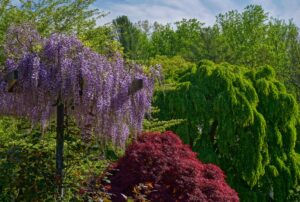
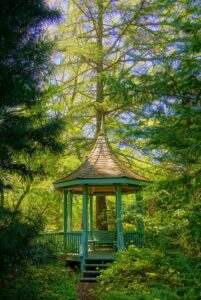
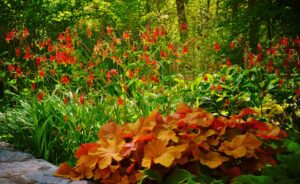
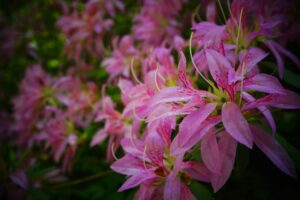
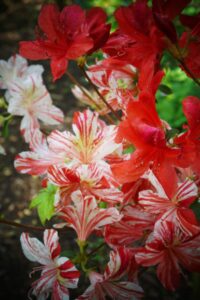
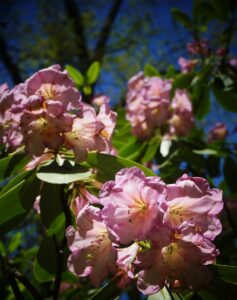
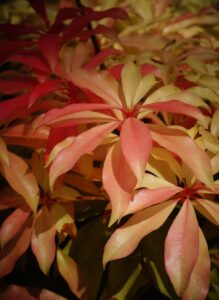
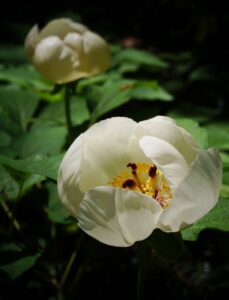
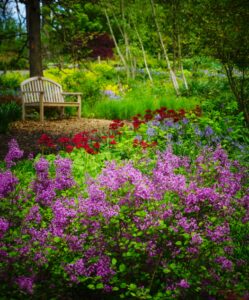
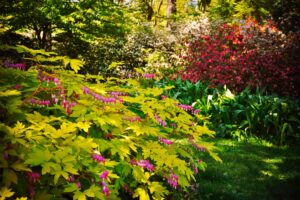
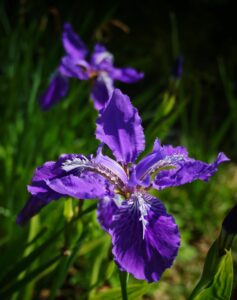
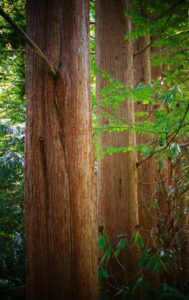
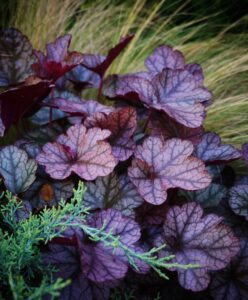
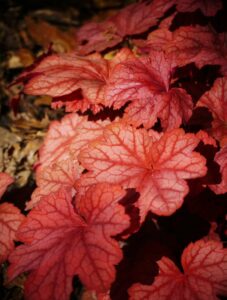
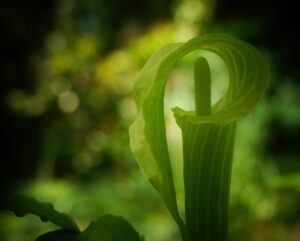
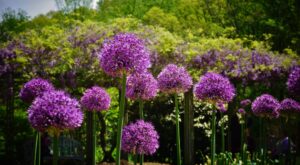
Knowledge shared is knowledge gained.